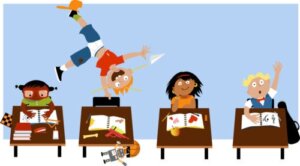6 Keys to Help a Child With ADHD to Control Their Impulses

Impulsivity is one of the main symptoms that children with attention deficit hyperactivity disorder (ADHD) deal with. This leads them to have problems in various areas of their lives, whether school, social, family, or work. However, this isn’t a behavior that children carry out on purpose rather, it occurs as a result of a malfunction of a brain area. Even so, with some useful keys, it’s possible to help a child with ADHD to control their impulses.
The work of the parents is fundamental, both as a guide and as a support for the child in their learning process. With patience and perseverance, they can teach and transmit tips and attitudes to help kids keep calm and achieve the self-control that’s so difficult for them. If your child is in this situation, we invite you to keep reading to learn how to help them.
Why should a child with ADHD learn to control their impulses?
First of all, it’s important to clarify what we mean when we talk about ADHD. It’s important to note that it’s a neurodevelopmental disorder, which begins in childhood and is characterized by a triad of typical manifestations:
- Attention deficit
- Hyperactivity
- Impulsivity
Although each child is different, these last two symptoms are usually more present in boys and seem to derive from the same problem: Difficulty inhibiting behavior.
Thus, these children have problems regulating their activation (which often overwhelms them), controlling themselves, and managing their impulses. Some of the most common manifestations of this impulsivity are the following:
- A tendency to interrupt and an inability to take turns.
- Difficulty tolerating frustration and delaying gratification. Failure to regulate their behavior based on long-term rewards.
- A lack of reflexivity and foresight of consequences. They find it difficult to analyze situations beforehand.
- Problems attending to long sentences or compound instructions, because they only follow the initial orders.
- A tendency to take risks and to be reckless.
- They say or do whatever crosses their mind, even if it’s wrong or unfortunate.

How to help a child with ADHD control their impulses?
If the above descriptions fit your child’s reality, we’ll suggest some guidelines that you can follow to help them achieve self-control.
1. Set clear, concrete rules
Give your child concrete rules and instructions that are easy for them to understand and that clearly describe what’s expected of them in each situation.
Try to use short, concise sentences without double meanings and avoid making too many statements at the same time. This way, you can make sure that your child has heard and understood the request. However, you may want to ask your child to repeat the rule to you to reinforce it. As much as possible, state the guidelines in positive terms. For example, “pick up your toys” is preferable to “don’t leave everything lying around”. Also, set clear consequences that will occur if the rules are broken. Your child should know these consequences in advance, and you should make sure they’re enforced whenever appropriate. Keep in mind that consistency is critical.
2. Instill the habit of deliberate reflection
Children with ADHD have great difficulty thinking before they speak or act. They also have difficulty perceiving the consequences of their actions. Therefore, it’s important to help and train them in this skill. To do this, every time your child has lost control, take some time to sit down with them and talk about what happened once they regain composure.
Ask them to think, analyze, and tell you what they felt, why they did what they did and what the consequences of their actions were. Finally, encourage them to reflect on other ways they could have acted and how they can do better next time. This process is more time-consuming than simply scolding them or telling them how to behave. However, by involving them, by prompting them to come to these conclusions on their own, they’re more likely to internalize them and implement them in future situations.
3. Rehearse with role-playing
At the same time, it can also be positive to analyze situations before they happen. This prior reflection will allow the child to have an idea of what’s going to happen and how to act.
So, before an event (for example, going to a birthday party), talk about what will happen there and what situations may occur there. This will help them anticipate some issues that may upset them or cause them to lose control and find strategies to avoid this outcome. In addition, at home, you can rehearse different everyday situations and the ways in which they should act in each of them. Puppets are a good option to represent such a rehearsal, but you can also role-play as well.
4. Give relevance to emotional education in your home
Impulsivity is an inability to regulate internal activation and therefore, the child needs to learn to relate to their emotions, perceive, understand, and manage them. In this regard, a very useful tool to achieve self-regulation is the emotional thermometer. This fantasy element allows the child to measure the degree of intensity of the emotion they feel and decide how to act in each case. For example, if the emotion reaches yellow, they should reflect on the best option before acting, and if it reaches red, they should stop immediately and calm down.

5. Opt for relaxation techniques
Relaxation techniques are an excellent tool to help a child with ADHD to control their impulses. There are variations adapted to childhood that are simple and fun and that the child can use whenever they feel that their impulses are getting the best of them.
In addition, if practiced regularly, you’ll notice that each day, they’re much calmer and it’s easier for them to perceive the moments when emotions grow in intensity.
6. Supervise and reinforce your child to help them control their impulses
Beyond all of the above, it’s very important for parents to be able to monitor their child’s behavior and provide feedback and guidance at every turn. Until they learn to manage autonomously, they’ll need to be reminded of the rules and urged to reflect or calm down. Being patient and persevering is essential.
Finally, remember to reinforce every achievement and progress your child makes. Keep in mind that these little ones have a hard time focusing on the long term, so find subgoals that they can meet and for which they can receive encouragement and praise before mastering the final behavior. With your help, they’ll be able to acquire the right tools and handle their impulses much better.
Impulsivity is one of the main symptoms that children with attention deficit hyperactivity disorder (ADHD) deal with. This leads them to have problems in various areas of their lives, whether school, social, family, or work. However, this isn’t a behavior that children carry out on purpose rather, it occurs as a result of a malfunction of a brain area. Even so, with some useful keys, it’s possible to help a child with ADHD to control their impulses.
The work of the parents is fundamental, both as a guide and as a support for the child in their learning process. With patience and perseverance, they can teach and transmit tips and attitudes to help kids keep calm and achieve the self-control that’s so difficult for them. If your child is in this situation, we invite you to keep reading to learn how to help them.
Why should a child with ADHD learn to control their impulses?
First of all, it’s important to clarify what we mean when we talk about ADHD. It’s important to note that it’s a neurodevelopmental disorder, which begins in childhood and is characterized by a triad of typical manifestations:
- Attention deficit
- Hyperactivity
- Impulsivity
Although each child is different, these last two symptoms are usually more present in boys and seem to derive from the same problem: Difficulty inhibiting behavior.
Thus, these children have problems regulating their activation (which often overwhelms them), controlling themselves, and managing their impulses. Some of the most common manifestations of this impulsivity are the following:
- A tendency to interrupt and an inability to take turns.
- Difficulty tolerating frustration and delaying gratification. Failure to regulate their behavior based on long-term rewards.
- A lack of reflexivity and foresight of consequences. They find it difficult to analyze situations beforehand.
- Problems attending to long sentences or compound instructions, because they only follow the initial orders.
- A tendency to take risks and to be reckless.
- They say or do whatever crosses their mind, even if it’s wrong or unfortunate.

How to help a child with ADHD control their impulses?
If the above descriptions fit your child’s reality, we’ll suggest some guidelines that you can follow to help them achieve self-control.
1. Set clear, concrete rules
Give your child concrete rules and instructions that are easy for them to understand and that clearly describe what’s expected of them in each situation.
Try to use short, concise sentences without double meanings and avoid making too many statements at the same time. This way, you can make sure that your child has heard and understood the request. However, you may want to ask your child to repeat the rule to you to reinforce it. As much as possible, state the guidelines in positive terms. For example, “pick up your toys” is preferable to “don’t leave everything lying around”. Also, set clear consequences that will occur if the rules are broken. Your child should know these consequences in advance, and you should make sure they’re enforced whenever appropriate. Keep in mind that consistency is critical.
2. Instill the habit of deliberate reflection
Children with ADHD have great difficulty thinking before they speak or act. They also have difficulty perceiving the consequences of their actions. Therefore, it’s important to help and train them in this skill. To do this, every time your child has lost control, take some time to sit down with them and talk about what happened once they regain composure.
Ask them to think, analyze, and tell you what they felt, why they did what they did and what the consequences of their actions were. Finally, encourage them to reflect on other ways they could have acted and how they can do better next time. This process is more time-consuming than simply scolding them or telling them how to behave. However, by involving them, by prompting them to come to these conclusions on their own, they’re more likely to internalize them and implement them in future situations.
3. Rehearse with role-playing
At the same time, it can also be positive to analyze situations before they happen. This prior reflection will allow the child to have an idea of what’s going to happen and how to act.
So, before an event (for example, going to a birthday party), talk about what will happen there and what situations may occur there. This will help them anticipate some issues that may upset them or cause them to lose control and find strategies to avoid this outcome. In addition, at home, you can rehearse different everyday situations and the ways in which they should act in each of them. Puppets are a good option to represent such a rehearsal, but you can also role-play as well.
4. Give relevance to emotional education in your home
Impulsivity is an inability to regulate internal activation and therefore, the child needs to learn to relate to their emotions, perceive, understand, and manage them. In this regard, a very useful tool to achieve self-regulation is the emotional thermometer. This fantasy element allows the child to measure the degree of intensity of the emotion they feel and decide how to act in each case. For example, if the emotion reaches yellow, they should reflect on the best option before acting, and if it reaches red, they should stop immediately and calm down.

5. Opt for relaxation techniques
Relaxation techniques are an excellent tool to help a child with ADHD to control their impulses. There are variations adapted to childhood that are simple and fun and that the child can use whenever they feel that their impulses are getting the best of them.
In addition, if practiced regularly, you’ll notice that each day, they’re much calmer and it’s easier for them to perceive the moments when emotions grow in intensity.
6. Supervise and reinforce your child to help them control their impulses
Beyond all of the above, it’s very important for parents to be able to monitor their child’s behavior and provide feedback and guidance at every turn. Until they learn to manage autonomously, they’ll need to be reminded of the rules and urged to reflect or calm down. Being patient and persevering is essential.
Finally, remember to reinforce every achievement and progress your child makes. Keep in mind that these little ones have a hard time focusing on the long term, so find subgoals that they can meet and for which they can receive encouragement and praise before mastering the final behavior. With your help, they’ll be able to acquire the right tools and handle their impulses much better.
All cited sources were thoroughly reviewed by our team to ensure their quality, reliability, currency, and validity. The bibliography of this article was considered reliable and of academic or scientific accuracy.
- Quintero, J., & Castaño de la Mota, C. (2014). Introducción y etiopatogenia del trastorno por déficit de atención e hiperactividad (TDAH). Pediatría integral, 18(9), 600-608.
- Sánchez Gómez, M., & Adelantado Renau, M. (2019). El termómetro emocional: una
herramienta educativa para facilitar la comprensión de emociones. Publicaciones didácticas, 105 pp. 301-305. Recuperado de
http://repositori.uji.es/xmlui/bitstream/handle/10234/183167/64308.pdf?sequence=1&is
Allowed=y
This text is provided for informational purposes only and does not replace consultation with a professional. If in doubt, consult your specialist.








